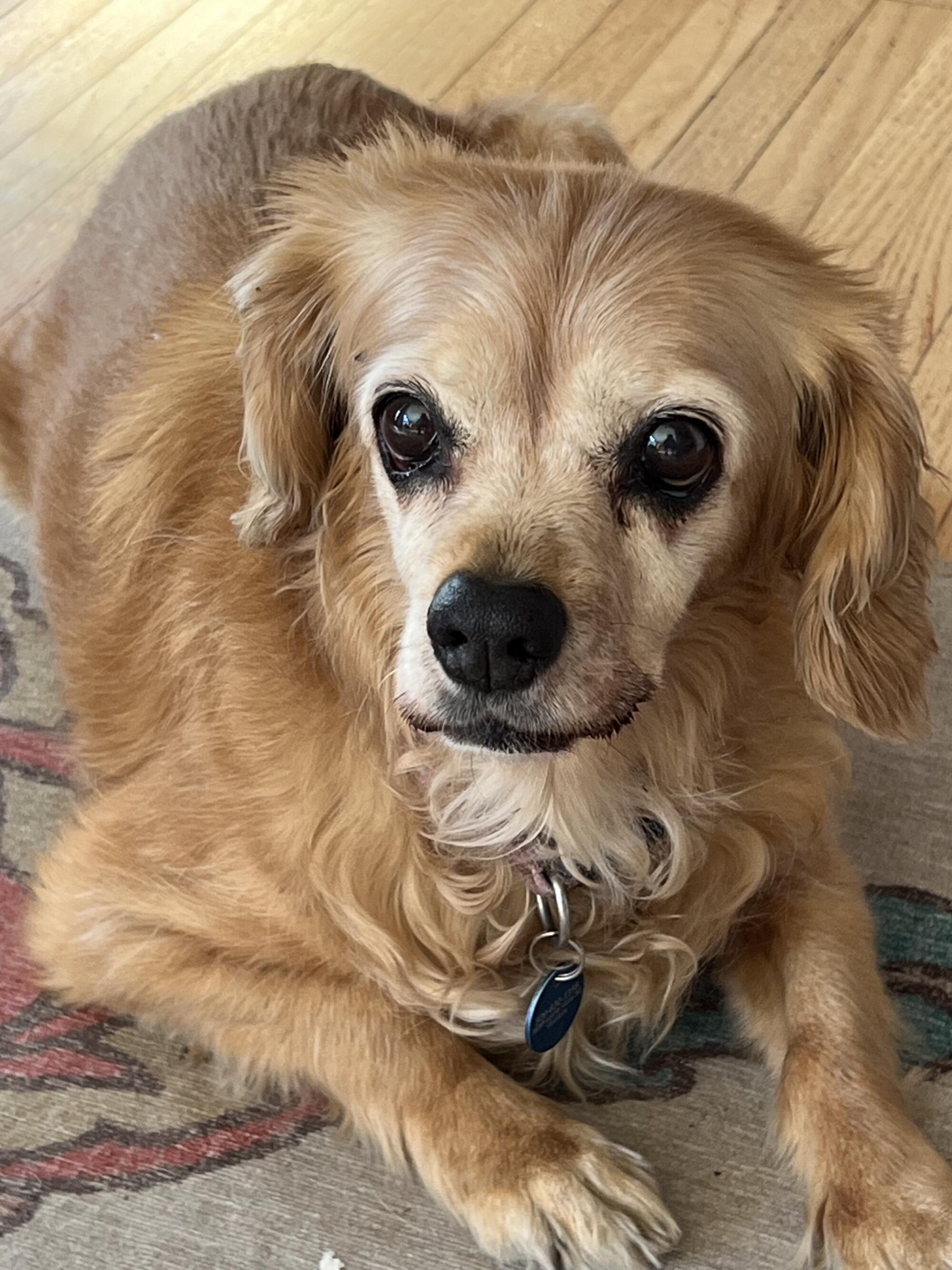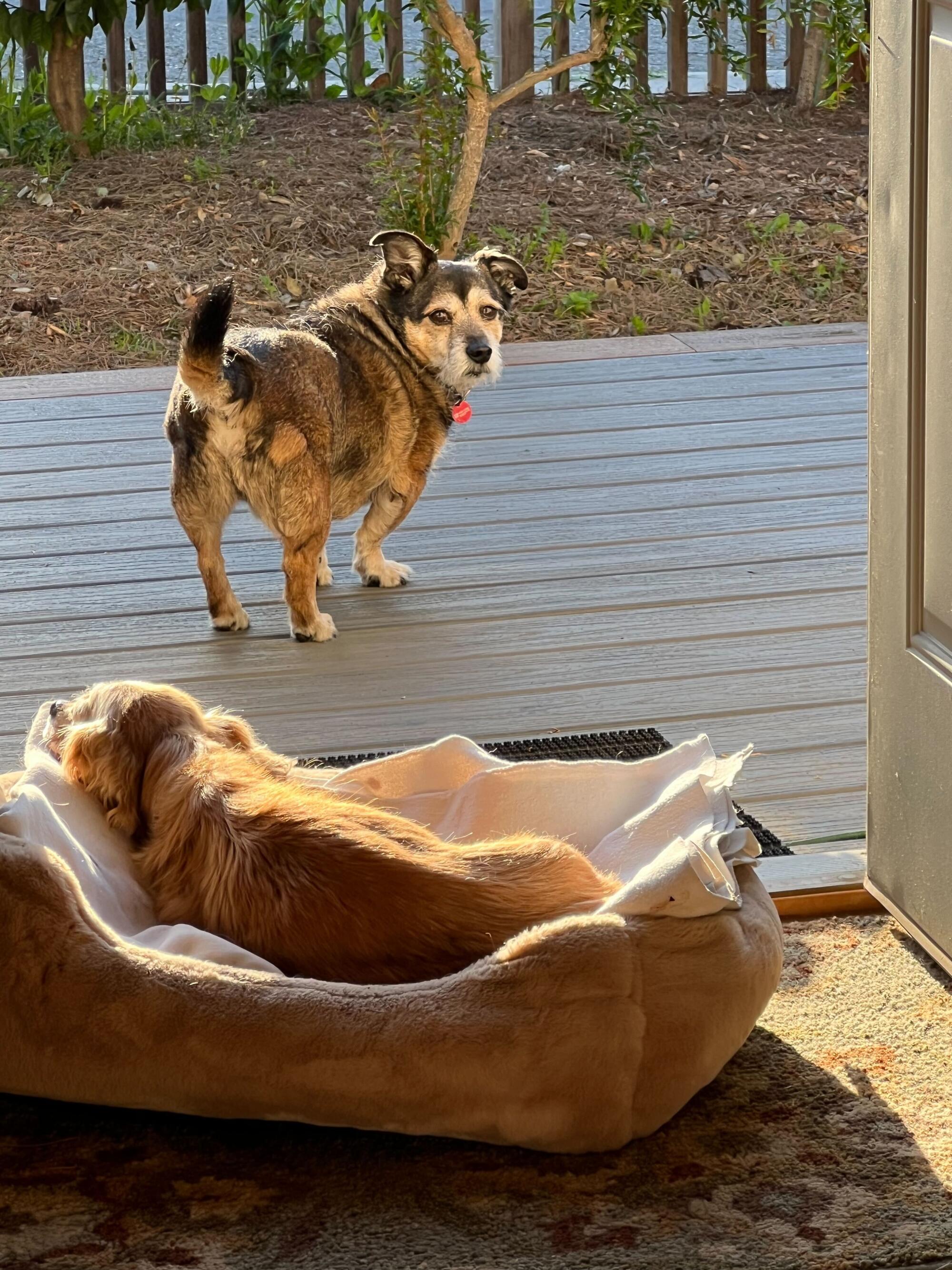Mazie was my sweet girl, a jaunty caramel-colored spaniel with bulgy brown eyes that radiated love, even in her final days when she fell almost every time she tried to stand.
At least, that’s the version I want to believe. But since Mazie died on April 29, I’ve talked to veterinarians who say our dog and cat companions don’t show pain the way humans do. So was it really love in her eyes at the end, or was it desperation?
We never knew Mazie’s origin story. My sister, a former animal control officer, spotted her running in heavy traffic in 2012 and managed to coax her into her car. We spent a couple months searching for her owner — she was such a beautiful dog we figured somebody must be missing her — but Mazie wasn’t chipped and no one claimed her, so she joined our family, first in my sister’s home and finally mine, where she became a doting companion to my late husband, who had Alzheimer’s.

Mazie, the mischievous cocker spaniel, in December 2023, shortly before her health began to decline.
(Jeanette Marantos)
She was definitely a looker, prancing like a show dog after she was groomed, and was always cheerful and loving — except with lizards, whom she hunted and devoured with relish. In her glory years, she’d dart out of open doors or find the tiniest opening in a fence, and run down the street, looking back at her pursuers with laughing eyes. We couldn’t stop her on foot, but she wasn’t hard to catch. The chase ended with someone driving by her side. She’d jump in the car happily, give her captor a toothy grin and then curl into a contented nap, probably dreaming of her next escape.
We guessed her age at about 15 when her decline began. Over the next year and a half, she slowly deteriorated from a nimble, mischievous little mutt who adored our daily jaunts to a deaf and shrunken trooper who staggered with a drunken lilt but still insisted on “walkies” even though her pace was glacial and she couldn’t manage more than a couple blocks.
I agonized about what to do but never made concrete plans. Instead, I fretted — how do you know when it’s time to say goodbye?
I’d always told myself, “When she stops eating, that’s when I’ll know,” but Mazie ate heartily up until her last few days. She slept more and more, but anytime I changed rooms she would slowly rouse herself and follow on unsteady, spindly legs. Our kind veterinarian shook her head at Mazie’s tenacity and said, “She’ll let you know when she’s ready to go,” but my sweet girl seemed stubbornly intent on staying alive and I had neither the heart nor the will to intervene.

Mazie’s last day, taking in some sun in her bed in the backyard, where she loved to bask and play. Her companion Bruin kept close in her final hours.
(Jeanette Marantos )
Instead I did what apparently many people do. I froze in my grief and my guilt, and watched her waste away. I didn’t want her to die in a sterile exam room. And when I called a mobile vet, just randomly chosen from online, I recoiled when they quoted a fee of $750. So I stalled.
I think I was hoping for some kind of Hollywood death, where she would give me one last affectionate lick, then close her eyes and quietly die. And that’s kind of what happened until her final hours when her breathing became so labored she was writhing and wrenching herself upright trying to get air.
That memory haunts me. I sat beside her that whole day, the way I attended the deaths of five people I loved, but they had hospice drugs to ease their passing. Why couldn’t I do better for my little dog?
There’s no magic formula
“These are not easy decisions; who wants to play God?” said veterinarian Lorraine Watson of DR 4 PETS, a home euthanasia service for dogs and cats. “But you have to set some guidelines, and think about their quality of life. Our animals don’t complain, they just live in the moment, and if you provide them with the basic necessities to keep going they can keep going for a long time, but are they happy? Because that’s just as important as whether they’re still eating.”
There isn’t really a magic formula for knowing when it’s time, said veterinarian Robin Holmes, who worked in general practice for 20 years until 2013, when she founded Gifts of Peace, an in-home pet euthanasia service serving the San Gabriel Valley. Even with all her experience, Holmes said she struggled with the decision about when to euthanize her ailing elderly dog Gemios “a 20-pound fluff ball” who had been in her family for years.
“These are not easy decisions; who wants to play God?”
— Lorraine Watson
“You would think with all my knowledge I would just look at things medically, but every time I’d think, ‘Oh it’s time,’ he’d have a couple of good days.” Ultimately, it was her ex-husband who helped her decide. He kept Gemios for a weekend when she had to travel and when she returned, he said, “‘You do know it’s time to make this decision?’ And yes, I knew it in my heart, but it was still hard for me to make that decision. And three months later, I’m still grieving.”
Oftentimes, Holmes said, veterinarians will just tell people, “‘She’ll let you know’ and ‘As long as she’s still eating, she’s fine,’ but I’d like that last phrase to get lost because our patients will eat because their body says they need to eat; it’s not an indication of good quality of life. I always tell people to just trust your instincts because you know them best.”
All things considered, I was lucky that Mazie’s death was relatively peaceful until the end, Watson said, but if she’d had cancer or muscular/skeletal problems like painful arthritis, her suffering could have been much worse,” and that crosses the line. That’s why you need to be in tune with your pet to see the signs of pain.”
For example, Watson said, a big dog might pace or circle for a while to lie down because it hurts so much to get down. They might stumble or fall often or get trapped behind furniture because their legs aren’t working well. They might be panting or breathing rapidly even at rest because they’re hurting, and their facial expressions will change. “Their ears aren’t up or their eyes aren’t fully open or bright or you get a grimace expression on a cat, or they’re withdrawing and hiding under the bed. Withdrawing is what wild animals do in nature. They get left behind by the pack or they’ll hide under a bush because they know something’s not right. And it’s the same with our pets, they’ll withdraw and oftentimes not interact as much with their people because they don’t feel well.”
Pain can also lead to appetite suppression, she said, so the animals start losing weight along with muscle mass, making them weaker and more skeletal.
In the wild, weak animals don’t last long, Watson said. In our homes, we can nurse them along with medications and carry them outside to pee, but at a certain point we have to consider their quality of life.
She recommends using a calendar to note whether your pet had a good day or bad day and soon a picture will emerge. “Is your dog happy being alive?” she said. “Is it able to do at least some of the things that made it happy in the past? If they’re just getting up to poop and eat during the day and then go back to bed, who wants to live like that?”
Plan before grief begins
Ultimately, it helps to reframe the way people think about pet euthanasia, said veterinarian Shea Cox co-founder of Honor Pet, a new “end-of-life-care” facility in downtown L.A. that provides comfort rooms where families can be with their pets during euthanasia in an unrushed, home-like setting.

One of the “comfort rooms” at Honor Pet in downtown Los Angeles, that are designed to mimic a comfortable home environment large enough to hold multiple people who want to gather to celebrate and support a pet during their euthanasia.
(Storyforma)
“In cases of terminal illness or natural decline, death isn’t something we’re initiating — it’s already in motion,” Cox wrote in an email. “The decision isn’t between life and death but between a longer or shorter journey to the inevitable.”
There’s a lot of gray area in making these decisions, but all three say it’s vital for pet owners to start investigating their options well before they’re in the throes of grief.
“Lots of times people say, ‘This must be such a hard job for you,’ but it’s not really,” Holmes said. “I find the person losing their pet is doing the hardest work, having to make very emotional decisions sometimes in the dark and sometimes without a lot of information. Really, nothing in life prepares us for making these decisions [about euthanasia] because inevitably when you start to consider it, and think maybe it’s time, suddenly they perk up and then you feel guilty — ‘How can I be thinking this?’”
So while there are no magic answers, preparation can help. Our pets’ lifespans are so short, you don’t need to wait until they’re sick to start investigating your options, and what you’re able to spend.
For instance, if I’d made more calls when I was less emotional, I would have discovered there are many in-home euthanasia services in the Greater Los Angeles area but most ask people to call for pricing. Only a few, like DR 4 PETS, list their prices online, starting as low as $450 for euthanasia for dogs 20 pounds and under, and as high as $850 for euthanasia and individual cremation for dogs between 51 and 78 pounds. Be sure to ask what the pricing includes because the fees often include the cost of cremation; so when I called in anguish and got my $750 quote over the phone, if I’d known to ask, I might have also discovered that the fee was less if I only wanted euthanasia.
I have a large yard, and Mazie was a relatively small dog, so after she died, I dug a deep hole, wrapped her in a cotton shawl and buried her, but that’s not an easy option for people who don’t have yards or have very large dogs. Most, Watson said, opt for some kind of cremation.
Most veterinary clinics and in-home euthanasia services offer a choice of communal cremation, where the animal’s remains are scattered in the ocean or a private reserve, or the more expensive option of individual cremation, where their ashes are returned in a special container.
Cox’s business, Honor Pet, provides water cremation, a.k.a aquamation, on-site so if people use their facility to euthanize their pet, they can have aquamation done in the same facility. The process uses hot water mixed with an alkaline lye solution, so it’s more environmentally friendly than standard cremation, and usually more expensive.
The price of kindness
Honor Pet offers four large “comfort rooms” with rugs, couches and homey decor, where families can spend all the time they need to say goodbye. Price is the big advantage here, Cox said, since euthanasia at Honor Pet is $275, well below the cost of most in-home visits. It’s also designed to be more comfortable and welcoming than typical veterinary clinic exam rooms, with extras such as making bouquets and creating cards for your pet.
But if cost is an issue, euthanasia will likely be the least expensive in veterinary clinics and Watson said some clinics offer special euthanasia spaces to give their patients and their people more time and privacy, so it’s worth inquiring what kind of accommodations your vet may have.
Another consideration is the size of your pet, especially if they are suffering from mobility issues, a common problem for large dogs. Can you carry your dog from home to a clinic without adding to their pain? If home euthanasia is more than you can afford, ask your veterinarian about sedatives you can give your dog to ease their suffering when you transport them to the clinic.
But leaving home can be a real hardship for many ailing pets, no matter their size. Some dogs and cats panic in a clinic setting, or any new situation, so letting them die at home is a real kindness. This is where calling around ahead of time can help you know what to expect in terms of prices, procedures and availability when it comes time to make the call.
Note that many of these in-home vets work alone, so you may have to wait a day or two for an appointment. Most will sedate your pet before administering the euthanasia drug to minimize their discomfort, but it’s a good idea to call and ask questions beforehand, or at least browse their websites which usually have extensive blog posts covering all kinds of issues, from preparing children for a pet’s death to helping your other animals cope with the loss of a companion. Some, like Honor Pet, and the national chain Lap of Love, also offer grief counseling and support groups.

Miss Coco Chanel, the 17-year-old shih tzu dog of DR 4 PETS veterinarian Lorraine Watson, had sundowner’s dementia and anxiety that improved after a change in her diet and activities to keep her mentally stimulated. She seems to be enjoying her life now, Watson said, “but we have to keep reminding ourselves …, when those things change it’s time to say goodbye.”
(Lorraine Watson )
And you don’t have to make these decisions alone. Mobile vets do offer home consults, usually for a fee, and your regular veterinarian can help you discover if there are treatments that can restore your pet’s quality of life. Holmes warns that these home consults can sometimes be misleading — a dog who hasn’t moved much may perk up momentarily with a new visitor who has interesting smells, she said, but that doesn’t change the reality of his day-to-day life.
Still, there are treatments that can turn things around, Watson said. Small dogs, like her 17-year-old shih tzu, Miss Coco Chanel, tend to live longer than large breeds but they’re also more susceptible to suffer dementia. Coco developed sundowner’s syndrome, she said, panting and digging in the carpet “like clockwork when the sun went down. We could not comfort her,” Watson said, and she was so arthritic that she could barely walk.
But Watson tried a prescription diet for brain health that lifted the sundowner’s effect. “She’s happy now and doesn’t need her antianxiety meds. She loves to go on her little walks — yes, I’m one of the those crazy parents who have a stroller for their dog — and I let her walk as long as she wants to and when she gets tired I push her along until she gets a chance to sniff at all her favorite spots. And she looks forward to her food. We put it in different places around the house every day so she has to hunt for it, and she absolutely loves it,” Watson said.
“We try to keep her mentally fit, and I’m lucky because she responded, but we have to keep reminding ourselves: When those things change, when she’s not happy to see us every day or doesn’t want to go for her little walk, then we’ll know it’s time to say goodbye.”
This story originally appeared on LA Times


